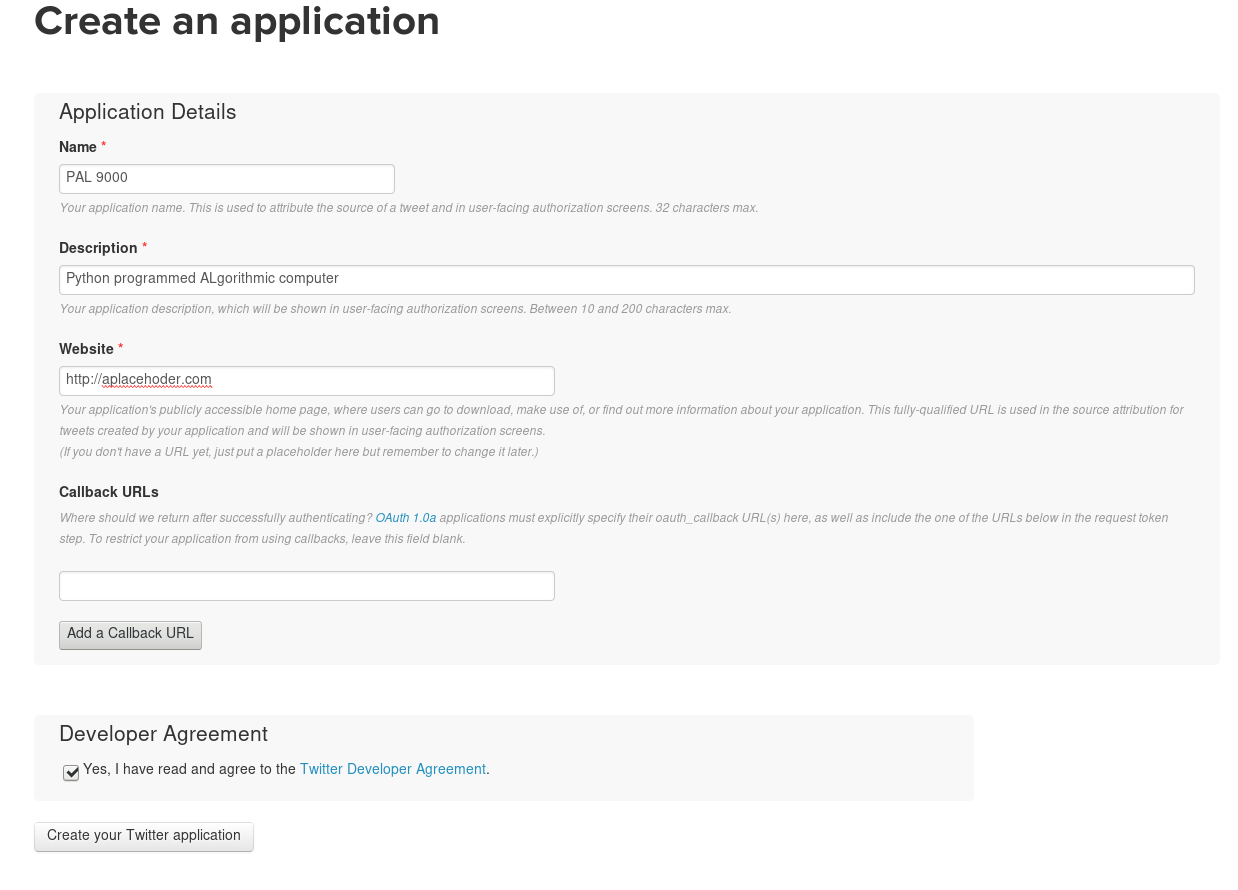5.0 KiB
学习如何使用 Python 构建你自己的 Twitter Bot
Twitter 允许用户向这个世界分享博客文章。使用 Python 和 Tweepy 拓展使得创建一个 Twitter 机器人来接管你的所有 tweeting 变得非常简单。这篇文章告诉你如何去构建这样一个机器人。希望你能将这些概念也同样应用到其他的在线服务的项目中去。
开始
tweepy 拓展可以让创建一个 Twitter 机器人的过程更加容易上手。它包含了 Twitter 的 API 调用和一个很简单的接口
下面这些命令使用 Pipenv 在一个虚拟环境中安装 tweepy。如果你没有安装 Pipenv,可以看一看我们之前的文章如何在 Fedora 上安装 Pipenv
$ mkdir twitterbot
$ cd twitterbot
$ pipenv --three
$ pipenv install tweepy
$ pipenv shell
Tweepy – 开始
要使用 Twitter API ,机器人需要通过 Twitter 的授权。为了解决这个问题, tweepy 使用了 OAuth 授权标准。你可以通过在 https://apps.twitter.com/ 创建一个新的应用来获取到凭证。
创建一个新的 Twitter 应用
当你填完了表格并点击了创建你自己的应用的按钮后,你可以获取到应用的凭证。 Tweepy 需要用户密钥 (API Key)和用户密码 (API Secret),这些都可以在 the Keys and Access Tokens 中找到
向下滚动页面,使用创建我的 Access Token 按钮生成一个 Access Token 和一个 Access Token Secret
使用 Tweppy —— 输出你的时间线
现在你已经有了所需的凭证了,打开一个文件,并写下如下的 Python 代码。
import tweepy
auth = tweepy.OAuthHandler("your_consumer_key", "your_consumer_key_secret")
auth.set_access_token("your_access_token", "your_access_token_secret")
api = tweepy.API(auth)
public_tweets = api.home_timeline()
for tweet in public_tweets:
print(tweet.text)
在确保你正在使用你的 Pipenv 虚拟环境后,执行你的程序
$ python tweet.py
上述程序调用了 home_timeline 方法来获取到你时间线中的 20 条最近的 tweets。现在这个机器人能够使用 tweepy 来获取到 Twitter 的数据,接下来尝试修改代码来发送 tweet。
使用 Tweepy —— 发送一条 tweet
要发送一条 tweet ,有一个容易上手的 API 方法 update_status 。它的用法很简单:
api.update_status("The awesome text you would like to tweet")
Tweepy 拓展为制作 Twitter 机器人准备了非常多不同有用的方法。获取 API 的详细信息,查看文档。
一个杂志机器人
接下来我们来创建一个搜索 Fedora Magazine 的 tweets 并转推这些 tweets 的机器人。
为了避免多次转推相同的内容,这个机器人存放了最近一条转推的 tweet 的 ID 。 两个助手函数 store_last_id 和 get_last_id 将会帮助存储和保存这个 ID。
然后,机器人使用 tweepy 搜索 API 来查找 Fedora Magazine 的最近的 tweets 并存储这个 ID。
import tweepy
def store_last_id(tweet_id):
""" Store a tweet id in a file """
with open("lastid", "w") as fp:
fp.write(str(tweet_id))
def get_last_id():
""" Read the last retweeted id from a file """
with open("lastid", "r") as fp:
return fp.read()
if __name__ == '__main__':
auth = tweepy.OAuthHandler("your_consumer_key", "your_consumer_key_secret")
auth.set_access_token("your_access_token", "your_access_token_secret") api = tweepy.API(auth)
try:
last_id = get_last_id()
except FileNotFoundError:
print("No retweet yet")
last_id = None
for tweet in tweepy.Cursor(api.search, q="fedoramagazine.org", since_id=last_id).items():
if tweet.user.name == 'Fedora Project':
store_last_id(tweet.id)
tweet.retweet()
print(f'"{tweet.text}" was retweeted'
为了只转推 Fedora Magazine 的 tweet ,机器人搜索内容包含 fedoramagazine.org 和由 「Fedora Project」 Twitter 账户发布的 tweets。
结论
在这篇文章中你看到了如何使用 tweepy Python 拓展来创建一个自动阅读、发送和搜索 tweets 的 Twitter 应用。现在,你能使用你自己的创造力来创造一个你自己的 Twitter 机器人。
这篇文章的演示源码可以在 Github 找到。
via: https://fedoramagazine.org/learn-build-twitter-bot-python/
作者:Clément Verna 选题:lujun9972 译者:Bestony 校对:校对者ID

